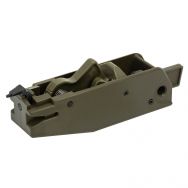

Some subtle changes were made in the 1990s to the fire control system. Over the years, the P220 design slowly, incrementally matured. In any case, this redesign kicked popularity of the P220. As an analogy, consider the original slim-handled P220 with the butt heel release as comparable to the original 1911 pistol, with its flat mainspring housing, and the more curving back of the P220 American as the analog to the arched mainspring housing of a 1911-A1. The result was a little bit fuller grasp, with a curve that descended outward on the lower rear edge. (And on the German Luger pistol before that.)Īt the same time, SIG changed the grip configuration of the P220. The key change was replacing what was perceived as an “old fashioned, European style†butt-heel magazine release with one more in keeping with Yankee tastes: a push button located behind the trigger on the left side of the frame, exactly where had been on the 1911 since, well, at least 1911. In both police and private citizen circles, the desirability and therefore the popularity of the P220 were greatly enhanced by SIG’s introduction of what was then called the P220 American, in the early 1980s.

SIG responded with a corporate shrug, returned the name Sig Sauer P220 to the pistol, and continued to market it, under its own name. 45 ACP generally acceptable in mainstream American law enforcement.īrowning’s customer base had been accustomed to finely polished blue steel and handsome checkered walnut the flatter, grayer finish and plastic grip panels of this European-made service pistol apparently caused a mass outbreak of cognitive dissonance among Browning’s fan base, which ignored the BDA in droves. Thus, one can honestly suggest that the SIG P220/Browning BDA was the pistol that made the. 45 very likely hastened the introduction of that first S&W. The success of the SIG-made double-action. 45 autos, starting with the Model 645, were still years away, as was the Glock, whose G21 in the same caliber would not appear until 1990. The BDA was approved by forward-thinking police departments such as that of Huntington Beach, California. The BDA of course lived up to its name: It was a double-action design, meaning that the hammer could be down at rest in the officer’s exposed holster, like the service revolver it replaced. 45 autos, but most chiefs (and a good number of handgun-owning citizens) were horrified at the concept of a duty handgun carried visibly cocked in its holster. Over the years, a handful of cops had been permitted to carry cocked and locked 1911. Where the BDA captured interest stateside was with the. Within a year, Browning had contracted with SIG to build this pistol in more powerful chambering, branding it as the Browning BDA, which redundantly stood for Browning Double Action. With its long history of peaceful neutrality secured by a citizenry heavily armed by its Government, Switzerland has a similarly long history of choosing particularly fine small arms. The P220 was designed by SIG in Switzerland, and manufactured by Sauer of Germany. There was, of course, a home court advantage: SIG stands for Schweizerische Industrie Gesselschaft, which in direct translation from German means Swiss Industrial Company. Introduced in 1976 as a single-stack 9mm with a butt heel magazine release, the Sig Sauer P220 was quickly adopted as the standard service pistol of Switzerland.


 0 kommentar(er)
0 kommentar(er)
